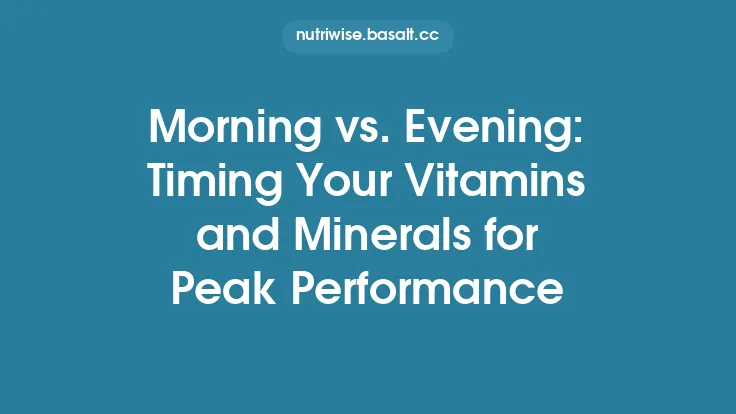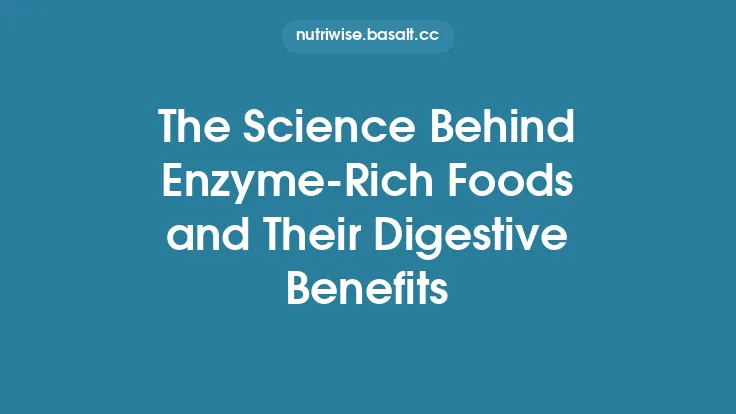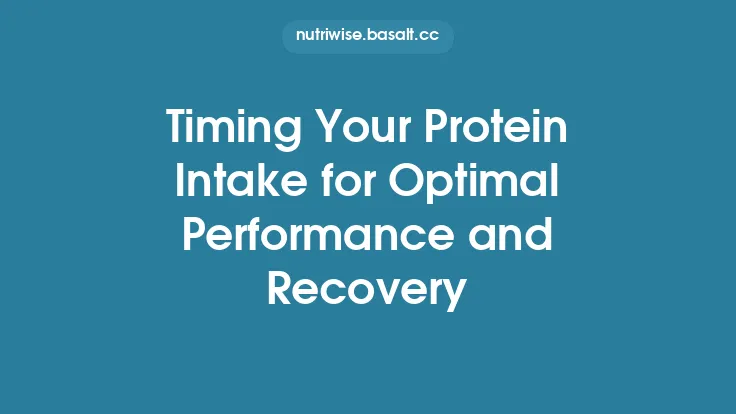The efficiency of the digestive machinery hinges not only on the presence of enzymes themselves but also on the tiny molecular partners that enable those enzymes to adopt the correct shape, bind substrates, and carry out chemistry at a rapid pace. These partners—co‑factors and vitamins—are often overlooked in popular discussions of nutrition, yet they are indispensable for optimal enzyme performance throughout the gastrointestinal tract. Below is a comprehensive exploration of the most important co‑factors and vitamins that support enzymatic digestion and nutrient breakdown, how they function at a molecular level, where they can be obtained from the diet, and what happens when they are lacking.
What Are Enzyme Cofactors?
Enzyme cofactors are non‑protein chemical entities that bind to an enzyme and are required for its catalytic activity. They fall into two broad categories:
- Metal Ions (Inorganic Cofactors) – such as zinc, magnesium, calcium, iron, copper, and selenium. These ions can either be tightly bound (prosthetic groups) or loosely associated (co‑enzymes) and often participate directly in the chemical transformation of the substrate.
- Organic Molecules (Cofactors or Co‑enzymes) – typically derived from vitamins. These molecules usually act as carriers of electrons, atoms, or functional groups during the reaction. When a vitamin‑derived co‑enzyme is required in only small amounts, it is termed a “co‑factor” in the strict sense; when larger amounts are needed, the term “co‑enzyme” is more appropriate.
Both types of cofactors can influence enzyme activity by:
- Stabilizing the three‑dimensional conformation of the protein.
- Providing essential chemical groups (e.g., sulfhydryl, phosphate) that participate in catalysis.
- Acting as electron donors or acceptors in redox reactions.
- Facilitating substrate binding through electrostatic interactions.
Metal Ions as Cofactors in Digestive Enzymes
| Metal Ion | Primary Role in Digestion | Representative Enzymes (examples) | Mechanistic Insight |
|---|---|---|---|
| Zinc (Zn²⁺) | Structural stabilization and catalytic activation | Carboxypeptidases, metalloproteases | Zinc’s tetrahedral coordination geometry allows it to polarize water molecules, generating a nucleophilic hydroxide that attacks peptide bonds. |
| Magnesium (Mg²⁺) | ATP‑dependent reactions, nucleic acid handling | Kinases involved in mucosal turnover, ATP‑dependent transporters | Mg²⁺ chelates the phosphate groups of ATP, positioning the γ‑phosphate for transfer to substrates. |
| Calcium (Ca²⁺) | Regulation of enzyme secretion and activation | Trypsinogen activation cascade (indirect), certain phospholipases | Calcium binds to specific loops on enzyme surfaces, inducing conformational changes that expose active sites. |
| Iron (Fe²⁺/Fe³⁺) | Redox catalysis in oxidative breakdown of certain nutrients | Peroxidases in the gut lumen | Iron cycles between oxidation states, enabling the reduction of hydrogen peroxide and the subsequent oxidation of substrates. |
| Copper (Cu⁺/Cu²⁺) | Electron transfer in oxidative reactions | Cu‑dependent oxidases that modify dietary polyphenols | Copper’s ability to alternate oxidation states facilitates the transfer of electrons from substrate to molecular oxygen. |
| Selenium (Se²⁻ as selenocysteine) | Antioxidant protection of enzymes | Selenoprotein enzymes that protect mucosal cells from oxidative stress | Selenocysteine’s selenol group is a potent nucleophile, allowing rapid reduction of peroxides that could otherwise inactivate digestive enzymes. |
Key Points
- Binding Affinity: Some metal ions are permanently bound (prosthetic groups) while others associate transiently during catalysis. The former often dictate enzyme folding, whereas the latter modulate activity in response to dietary intake.
- Competition and Antagonism: Excessive intake of one metal (e.g., high zinc) can interfere with the absorption of another (e.g., copper), potentially impairing enzyme function.
- Homeostatic Regulation: The gut epithelium possesses specialized transporters (e.g., ZIP and DMT1 families) that tightly regulate intracellular metal concentrations, ensuring that enzymes receive the correct stoichiometry of co‑factor.
Key Vitamins Serving as Cofactors
| Vitamin (Derivative) | Cofactor Form | Enzymatic Function in Digestion | Example Reaction |
|---|---|---|---|
| Vitamin B1 (Thiamine) | Thiamine pyrophosphate (TPP) | Decarboxylation of α‑keto acids in carbohydrate metabolism | Conversion of pyruvate to acetyl‑CoA in intestinal mucosal cells |
| Vitamin B2 (Riboflavin) | Flavin adenine dinucleotide (FAD) & flavin mononucleotide (FMN) | Oxidative dehydrogenation reactions | Oxidation of fatty acids during mucosal β‑oxidation |
| Vitamin B3 (Niacin) | Nicotinamide adenine dinucleotide (NAD⁺/NADP⁺) | Redox reactions in glycolysis and the pentose phosphate pathway | Oxidation of glyceraldehyde‑3‑phosphate in enterocytes |
| Vitamin B5 (Pantothenic Acid) | Coenzyme A (CoA) | Acyl‑group transfer, essential for fatty acid activation | Formation of fatty acyl‑CoA for subsequent β‑oxidation |
| Vitamin B6 (Pyridoxine) | Pyridoxal‑5′‑phosphate (PLP) | Aminotransferase reactions, decarboxylation of amino acids | Transamination of glutamate to α‑ketoglutarate in the gut wall |
| Vitamin B7 (Biotin) | Biotin (as a covalently attached prosthetic group) | Carboxylation reactions in gluconeogenesis | Carboxylation of acetyl‑CoA to malonyl‑CoA in intestinal cells |
| Vitamin B9 (Folate) | Tetrahydrofolate (THF) | One‑carbon transfers for nucleotide synthesis in rapidly dividing enterocytes | Conversion of dUMP to dTMP during DNA synthesis |
| Vitamin B12 (Cobalamin) | Methylcobalamin & adenosylcobalamin | Methyl group transfer and rearrangement reactions | Methylmalonyl‑CoA mutase activity in propionate metabolism |
| Vitamin C (Ascorbic Acid) | Direct antioxidant, regenerates other cofactors | Protects enzyme active sites from oxidative damage | Regeneration of α‑tocopherol (vitamin E) that stabilizes membrane‑bound enzymes |
| Vitamin D (Calciferol) | Calcitriol (active form) | Modulates expression of genes encoding digestive enzymes | Up‑regulation of pancreatic lipase gene transcription in the duodenum |
| Vitamin E (Tocopherol) | Lipid‑soluble antioxidant | Preserves the integrity of membrane‑bound enzymes | Prevention of lipid peroxidation that could impair brush‑border enzyme activity |
Mechanistic Highlights
- Electron Transfer: NAD⁺/NADP⁺ and FAD/FMN shuttle electrons between substrates and the respiratory chain, ensuring that oxidative steps in nutrient catabolism proceed efficiently.
- Group Transfer: PLP forms a Schiff base with amino acid substrates, enabling the removal of α‑hydrogens and facilitating transamination or decarboxylation.
- Acyl‑Group Activation: CoA thioesters are high‑energy intermediates that allow fatty acids to be processed by β‑oxidation enzymes within enterocytes.
- Gene Regulation: Certain vitamins (e.g., D) act as nuclear hormone ligands, binding to vitamin‑responsive elements in DNA and altering transcription of enzyme‑encoding genes.
Interaction Between Cofactors and Enzyme Structure
Cofactors influence enzyme architecture in several distinct ways:
- Induced Fit: Binding of a metal ion or organic co‑enzyme can trigger a conformational shift that aligns catalytic residues, a phenomenon first described by Koshland. For instance, the binding of Zn²⁺ to a metalloprotease repositions a catalytic glutamate into the active site, creating the optimal geometry for peptide bond hydrolysis.
- Stabilization of Transition States: Many co‑enzymes, such as PLP, form covalent intermediates with substrates that mimic the high‑energy transition state. This lowers the activation energy and accelerates the reaction.
- Allosteric Modulation: Some cofactors bind at sites distinct from the active site, altering enzyme dynamics. Calcium ions, for example, can bind to regulatory loops on certain digestive enzymes, enhancing their affinity for substrates.
- Protection from Denaturation: Antioxidant vitamins (C, E) protect enzyme sulfhydryl groups from oxidative modification, preserving catalytic competence under the oxidative environment of the gut lumen.
Dietary Sources of Essential Cofactors
| Cofactor | Primary Food Sources | Bioavailability Considerations |
|---|---|---|
| Zinc | Oysters, beef, pumpkin seeds, lentils | Phytates in whole grains can chelate zinc, reducing absorption; animal proteins enhance bioavailability. |
| Magnesium | Leafy greens (spinach), nuts, whole grains, dark chocolate | High fiber can bind magnesium; vitamin D status influences intestinal uptake. |
| Calcium | Dairy products, fortified plant milks, sardines with bones | Vitamin D is required for optimal calcium absorption; oxalates in spinach may inhibit uptake. |
| Iron (heme) | Red meat, poultry, fish | Heme iron is readily absorbed; non‑heme iron from plant sources benefits from concurrent vitamin C intake. |
| Copper | Shellfish, nuts, seeds, whole‑grain cereals | Excess zinc can impair copper absorption; balanced intake is key. |
| Selenium | Brazil nuts, seafood, organ meats | Soil selenium content dictates food levels; excessive intake can be toxic. |
| Thiamine (B1) | Whole grains, pork, legumes | Polishing of rice removes thiamine; alcohol consumption interferes with utilization. |
| Riboflavin (B2) | Dairy, eggs, almonds, mushrooms | Light exposure degrades riboflavin in foods; storage in opaque containers preserves it. |
| Niacin (B3) | Poultry, fish, peanuts, mushrooms | Tryptophan can be converted to niacin, but requires adequate B6 and iron. |
| Pantothenic Acid (B5) | Avocado, mushrooms, whole grains | Widely distributed; deficiency is rare. |
| Pyridoxine (B6) | Chickpeas, bananas, fish, potatoes | High protein diets increase B6 demand for amino‑acid metabolism. |
| Biotin (B7) | Egg yolk, nuts, soybeans | Raw egg whites contain avidin, which binds biotin and reduces absorption. |
| Folate (B9) | Leafy greens, legumes, citrus fruits | Folate is heat‑labile; cooking can reduce content unless fortified. |
| Cobalamin (B12) | Animal liver, clams, fortified cereals | Requires intrinsic factor for absorption; vegans may need supplementation. |
| Vitamin C | Citrus fruits, strawberries, bell peppers | Cooking destroys vitamin C; raw consumption maximizes intake. |
| Vitamin D | Fatty fish, fortified dairy, sunlight‑induced synthesis | Limited dietary sources; sun exposure is a major contributor. |
| Vitamin E | Sunflower seeds, almonds, spinach | Fat‑soluble; requires dietary fat for absorption. |
Factors Influencing Cofactor Availability
- Gastrointestinal Health: Conditions that impair mucosal integrity (e.g., celiac disease, inflammatory bowel disease) can reduce the expression of transporters for metals and vitamins, limiting co‑factor delivery to enzymes.
- Age: Elderly individuals often exhibit decreased gastric acid secretion, which hampers mineral solubilization and vitamin B12 release from food proteins.
- Medication Interactions: Proton‑pump inhibitors, diuretics, and certain antibiotics can alter the absorption of zinc, magnesium, and B‑vitamins.
- Dietary Patterns: High‑phytate, high‑oxalate, or high‑fiber diets may bind minerals, while excessive alcohol intake can deplete B‑vitamins and impair liver‑mediated activation of certain cofactors.
- Genetic Polymorphisms: Variants in genes encoding transport proteins (e.g., SLC30A8 for zinc) or enzymes that convert vitamins to their active co‑enzyme forms (e.g., MTHFR for folate) can affect individual co‑factor status.
Clinical Implications of Cofactor Deficiencies
- Zinc Deficiency: Leads to reduced activity of zinc‑dependent proteases and impaired mucosal repair, manifesting as chronic diarrhea and malabsorption.
- Magnesium Insufficiency: Diminishes ATP‑dependent transport processes, slowing nutrient uptake across the enterocyte brush border.
- Vitamin B6 Deficiency: Lowers PLP‑dependent transamination, resulting in accumulation of unmetabolized amino acids and potential neuro‑gastrointestinal symptoms.
- Folate Deficiency: Impairs nucleotide synthesis in rapidly dividing enterocytes, compromising the renewal of the absorptive surface and leading to villous atrophy.
- Vitamin D Deficiency: Reduces transcription of certain digestive enzymes and transporters, contributing to suboptimal lipid absorption.
- Selenium Deficiency: Weakens selenoprotein antioxidant defenses, making digestive enzymes more susceptible to oxidative inactivation.
Early detection through targeted laboratory assays (serum zinc, magnesium, B‑vitamin panels, 25‑hydroxyvitamin D) can guide nutritional or pharmacologic interventions before overt malabsorption develops.
Strategies to Optimize Cofactor Status for Digestive Health
- Balanced, Whole‑Food Diet: Prioritize a variety of animal and plant sources to supply both inorganic and organic cofactors. Pair iron‑rich foods with vitamin C to enhance non‑heme iron absorption.
- Timed Nutrient Pairing: Consume calcium‑rich foods separately from high‑iron meals to avoid competitive inhibition; similarly, avoid excessive zinc supplementation when taking copper‑containing supplements.
- Cooking Techniques: Lightly steam or stir‑fry vegetables to preserve water‑soluble B‑vitamins while reducing antinutrient content (phytates, oxalates) that bind minerals.
- Supplementation When Needed: For individuals with documented deficiencies or malabsorptive conditions, targeted supplementation (e.g., zinc gluconate, methylcobalamin, magnesium citrate) under professional supervision can restore co‑factor levels.
- Lifestyle Adjustments: Encourage safe sun exposure or vitamin D‑fortified foods for those with limited dietary intake; limit alcohol and smoking, which deplete several B‑vitamins.
- Monitoring and Re‑assessment: Periodic evaluation of co‑factor status, especially in at‑risk populations (elderly, pregnant women, patients with chronic gastrointestinal disease), ensures that enzyme performance remains optimal.
By appreciating the nuanced roles of metal ions and vitamin‑derived co‑enzymes, nutrition professionals and health‑conscious individuals can move beyond the simplistic view of “eating enzymes” and instead focus on the microscopic allies that empower those enzymes to work efficiently. Ensuring an adequate supply of these cofactors through thoughtful dietary choices, lifestyle habits, and, when necessary, targeted supplementation, lays a solid biochemical foundation for robust digestive function and overall nutrient utilization.





